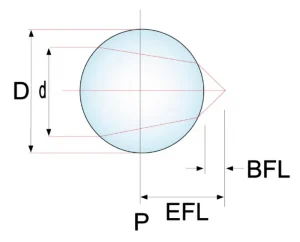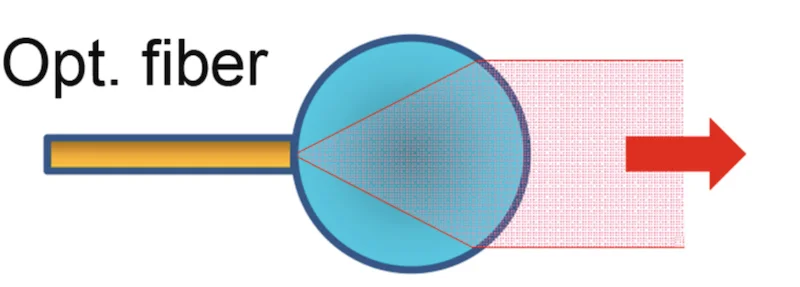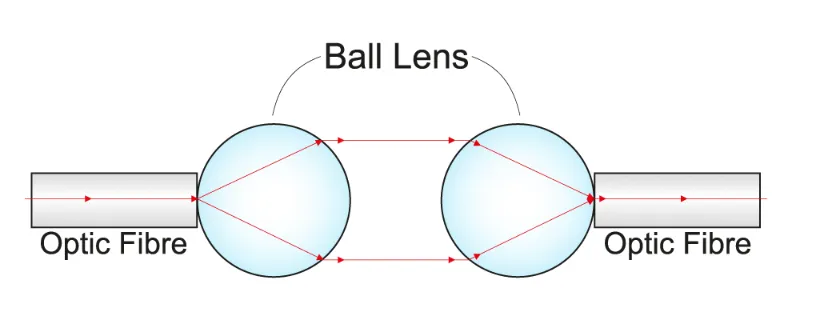Introduction

Ball lenses are versatile optical components that find applications in various fields, including fiber optics, endoscopy, barcode scanning, and sensor applications. In this comprehensive guide, we will explore the fundamentals of ball lenses, their manufacturing process, practical applications, and tips for selecting the right ball lens for your specific needs.
Ball lenses are small spherical lenses made from optical glass or other transparent materials. They exhibit the unique property of collimating light, which means they can focus incoming light to a point or make parallel rays converge. This makes them valuable in a wide range of optical systems. Ball lenses come in different types, including half-ball lenses, which are obtained by cutting a ball lens in half.
Understanding Optical Ball Lenses
Ball lenses are characterized by their diameter, effective focal length (EFL), and back focal length (BFL). The EFL is the distance from the lens at which the incoming light is focused, while the BFL is the distance from the lens to the focal point on the opposite side. The refractive index of the ball lens material also plays a crucial role in determining its optical properties.
To understand the behavior of ball lenses, it is important to consider the principles of refraction. When light passes through a ball lens, it undergoes refraction at each interface due to the change in the refractive index. The shape of the ball lens allows it to bend the light rays, focusing them to a point or collimating them, depending on the application.
Ball lenses are particularly useful in applications that require focusing or collimating light. The effective focal length of a ball lens determines the distance at which incoming light is focused. By manipulating the distance between the ball lens and the light source, you can control the focal point and achieve the desired beam characteristics.
However, ball lenses are not without limitations. Spherical aberrations can occur, leading to imperfections in the focused spot size. Understanding the limitations and trade-offs associated with ball lenses is crucial for optimizing their performance in optical systems.
Essential Equations for Using Ball Lenses
When using ball lenses in optical applications, several key equations are essential to understand their performance and design requirements. Ball lenses are often used in fiber optic coupling, laser collimating, and focusing applications due to their simple geometry and ease of alignment. Here are the essential equations:

1. Effective Focal Length (EFL):
- Formula:
- This formula calculates the EFL using the Diameter of the Ball Lens (D) and its Index of Refraction (n). EFL is measured from the center of the ball lens.
2. Back Focal Length (BFL):
- Formula:
- Once you know the EFL and the Diameter of the Ball Lens (D), you can easily calculate the BFL.
3. Numerical Aperture (NA) for Collimated Incident Light:
- Formula:
- This equation relates the size of the ball lens (D), its index of refraction (n), and the diameter of the input source (d). It assumes the refractive index outside of the ball lens equals 1.
4. NA in the Paraxial Limit:
- Formula:
- This is an estimation of the numerical aperture in the paraxial limit, where the diameter of the input source (d) is much smaller than the diameter of the ball lens (D).
Manufacturing of Ball Lenses
The manufacturing process of ball lenses involves precision machining and polishing techniques. High-quality optical glass or other materials are used as substrates, which are then shaped into spherical forms through grinding and polishing. The final step is to ensure the surface quality and accuracy of the ball lens, which is achieved through rigorous quality control measures.
Different materials can be used for ball lenses, including UV grade fused silica, sapphire, and BK7 glass. Each material has its own unique properties, such as high transmission in specific wavelength ranges or resistance to scratches and environmental conditions.
When it comes to manufacturing ball lenses, precision is key. The diameter and surface quality of the ball lens are critical for its performance. Various techniques, such as diamond turning and single-point diamond turning, are employed to achieve the desired shape and surface finish. The manufacturing process also involves polishing the ball lens to remove any imperfections and enhance its optical properties.
Ball Lenses Focusing and Aberration in Optics
Ball lenses are particularly useful in applications that require focusing or collimating light. The effective focal length of a ball lens determines the distance at which incoming light is focused. By manipulating the distance between the ball lens and the light source, you can control the focal point and achieve the desired beam characteristics.
In addition to focusing, ball lenses can also be used to collimate light. Collimation refers to the process of making parallel rays converge or diverge. Ball lenses with a longer focal length can collimate light, allowing for applications such as beam expansion or coupling light into optical fibers.
However, it is important to note that ball lenses are not free from optical aberrations. Spherical aberrations can occur, leading to imperfections in the focused spot size. This is due to the spherical shape of the lens, which causes rays farther from the lens axis to focus at different points compared to rays closer to the axis. The impact of spherical aberration can be minimized by carefully selecting the appropriate ball lens parameters and considering corrective measures such as aspheric lenses
Practical Applications of Ball Lenses
Ball lenses have a wide range of practical applications across various industries. Here are some notable examples:
1. Laser to Fiber Coupling:

Ball lenses are commonly used to couple laser beams into optical fibers. The diameter of the input laser beam, the refractive index of the ball lens, and the numerical aperture of the fiber optic are key parameters to consider for efficient coupling.
Laser to fiber coupling is a critical process in fiber optics, enabling efficient transmission of laser light through optical fibers. Ball lenses play a crucial role in this process by focusing the laser beam into the fiber core. The diameter of the input laser beam should match the diameter of the ball lens to ensure efficient coupling. The refractive index of the ball lens material is also important, as it affects the bending of light and the numerical aperture of the system. The numerical aperture, defined as the sine of the maximum angle of light accepted by the fiber, should be considered when selecting the ball lens. By carefully choosing the ball lens diameter, refractive index, and numerical aperture, optimal laser-to-fiber coupling efficiency can be achieved.
2. Fiber to Fiber optics Coupling:

In fiber optic systems, ball lenses can be employed to couple light between two fibers. Similar considerations regarding the diameter of the ball lens, refractive index, and numerical aperture need to be taken into account.
Fiber to fiber coupling involves the efficient transfer of light from one fiber to another. Ball lenses play a crucial role in this process by focusing and collimating light to achieve efficient coupling between the fibers. The diameter of the ball lens should match the fiber diameter to ensure optimal coupling efficiency. The refractive index of the ball lens material and the numerical aperture of the fibers are also important factors to consider. By carefully selecting the appropriate ball lens parameters, such as diameter and refractive index, efficient fiber to fiber coupling can be achieved.
3. Barcode Scanning:
Ball lenses play a crucial role in barcode scanning devices, where they help focus and collimate light to achieve accurate scanning and decoding.
Barcode scanning devices rely on the precise focusing and collimation of light to accurately decode barcodes. Ball lenses are used in these devices to focus the incoming light onto the barcode surface and collimate the reflected light for accurate detection. The ball lens ensures that the light beam is properly focused and collimated, enabling the barcode scanner to capture and decode the barcode information with high accuracy.
4. Endoscopy:
In medical endoscopy, ball lenses are used to focus light into the endoscope’s optical fibers, allowing for visualization inside the body.
Endoscopy is a medical procedure that involves inserting a flexible or rigid tube with an attached camera into the body to visualize internal organs and tissues. Ball lenses are used in endoscopes to focus light onto the object being examined. The ball lens focuses the light onto the optical fibers within the endoscope, allowing for clear visualization of the internal structures. The ability of the ball lens to precisely focus the light is crucial for obtaining high-quality images during endoscopic procedures.
5. Optical Sensors:
Ball lenses find applications in optical sensors, where they help focus or collimate light for precise detection and measurement.
Optical sensors are devices that detect and measure light or changes in light intensity. Ball lenses are commonly used in optical sensors to focus or collimate light onto the sensor element, ensuring accurate detection and measurement. Whether it is for detecting changes in environmental conditions, monitoring light intensity, or measuring distances, ball lenses play a critical role in optimizing the performance of optical sensors.
6. Microscopy Objectives (Immersion Objectives):
Ball lenses can be used as immersion objectives in microscopy applications, where they help achieve high-resolution imaging by focusing light through an immersion medium.
Microscope objectives are essential components in microscopy systems, enabling high-resolution imaging of microscopic samples. Ball lenses can be used as immersion objectives, where they are placed in contact with a liquid or oil immersion medium. The ball lens focuses the light onto the sample, allowing for enhanced resolution and improved image quality. The use of immersion objectives, including ball lenses, is particularly beneficial in high-resolution microscopy techniques such as confocal microscopy and super-resolution imaging.
These are just a few examples of the wide-ranging applications of ball lenses. Their versatility makes them an essential component in various optical systems, enabling precise focusing, collimation, and efficient coupling of light.
Selecting the Right Ball Lens
When selecting a ball lens for a specific application, several factors should be considered. These include the diameter of the ball lens, the effective focal length required, the refractive index of the material, and the desired numerical aperture. Understanding your specific requirements and the trade-offs associated with different parameters will help you choose the most suitable ball lens for your application.
The diameter of the ball lens is a crucial parameter to consider, as it affects the focusing and collimating properties of the lens. The diameter should be chosen based on the size of the input beam or the fiber core, ensuring efficient coupling or collimation. The effective focal length (EFL) of the ball lens determines the distance at which the light is focused. It should be selected based on the specific application requirements, such as the desired working distance or the focal point position.
The refractive index of the ball lens material plays a significant role in determining the bending of light and the numerical aperture (NA) of the system. The refractive index affects the critical angle at which light can be transmitted through the lens, impacting the numerical aperture and the acceptance angle of the lens. Consideration should be given to the refractive index of the material to ensure optimal performance in the desired wavelength range.
The numerical aperture (NA) is a measure of the light-gathering ability of the lens and determines the acceptance cone angle of the lens. It is defined as the sine of the maximum angle of light accepted by the lens. The numerical aperture is influenced by the refractive index and the diameter of the ball lens. A higher numerical aperture allows for a wider acceptance angle and increased light-gathering ability.
Other factors to consider when selecting a ball lens include the material properties, such as transmission characteristics, durability, and resistance to environmental conditions. Some commonly used materials for ball lenses include N-BK7 glass, UV grade fused silica, and sapphire. Each material has its own unique properties, such as high transmission in specific wavelength ranges or resistance to scratches and environmental conditions. Careful consideration should be given to the material properties to ensure compatibility with the specific application requirements.
Consulting with optical component suppliers, such as Edmund Optics or Newport, can provide valuable insights and expert advice in selecting the right ball lens for your needs. Supplier datasheets and catalogs offer detailed specifications and guidance for choosing the appropriate ball lens.
Maintenance, Care, and Coating Options for Ball Lenses
To ensure optimal performance and longevity of ball lenses, proper maintenance and care are essential. Here are some tips:
Cleaning and Handling:
Clean ball lenses using appropriate cleaning solutions and techniques to remove dust, oils, or other contaminants. Handle them with clean, lint-free gloves or tweezers to avoid fingerprints or scratches.
Storage:
Store ball lenses in a clean, dry environment to prevent moisture or dust accumulation. Consider using protective cases or containers to safeguard their surface quality.
Coating Options:
Ball lenses can be coated with various materials to enhance their performance. Antireflection (AR) coatings help minimize reflections and improve transmission, while other coatings can provide additional functionalities such as scratch resistance or hydrophobic properties. Low-pressure chemical vapor deposition (LPCVD) coating is a common technique used for ball lenses.
By following these maintenance practices and exploring coating options, you can optimize the performance and durability of your ball lenses.
The Future of Ball Lenses
As technology advances, the demand for ball lenses and their applications is expected to grow. Emerging trends, such as autonomous driving and optical technology advancements, are driving the need for high-quality optical components. Ball lenses, with their unique properties and versatile applications, are poised to play an important role in shaping the future of optics.
With the increasing demand for high-speed data transfer, the telecom industry is constantly evolving. Ball lenses will continue to be essential components in fiber optic networks, helping to improve data transfer efficiency and enable high-bandwidth communications. The ongoing advancements in fiber laser systems also rely on ball lenses for efficient coupling and collimation of laser beams.
In addition to telecom and fiber optics, ball lenses have promising applications in various fields. For example, in the medical industry, ball lenses are used in endoscopy to visualize internal organs and facilitate minimally invasive procedures. In the field of barcode scanning, ball lenses enable accurate decoding of barcodes by focusing and collimating light onto the barcode surface.
The future of ball lenses also lies in advancements in manufacturing techniques and materials. The development of new materials with improved optical properties and manufacturing processes with higher precision will further enhance the performance of ball lenses. This, in turn, will expand their applications and contribute to advancements in various industries.
Conclusion
Ball lenses are invaluable optical components with a wide range of applications in fiber optics, endoscopy, barcode scanning, and sensor technologies. Understanding the fundamentals of ball lenses, their manufacturing process, and practical considerations for their use is crucial for optimizing their performance in optical systems. By selecting the right ball lens, maintaining proper care, and exploring coating options, you can leverage the unique properties of ball lenses to enhance the efficiency and precision of your optical systems. As technology continues to advance, ball lenses will continue to be at the forefront of optical innovations, driving new possibilities in various industries.

